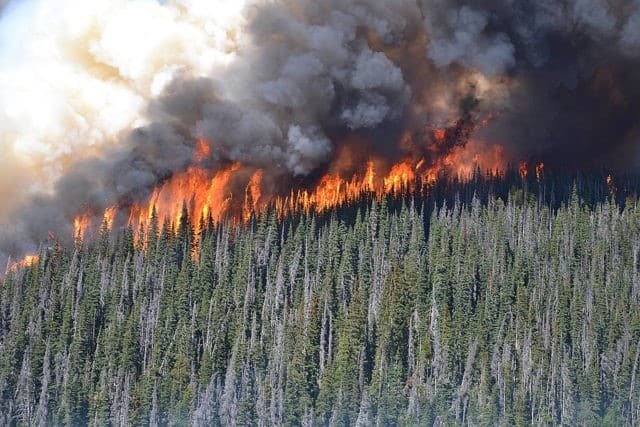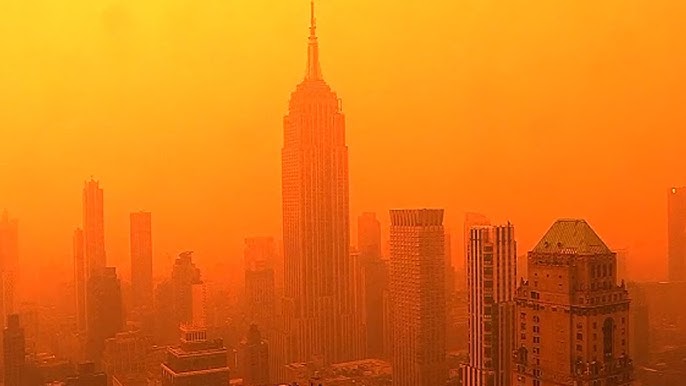Hotter, drier conditions due to increasing greenhouse gas pollution or climate change, make wildfires like the current Canadian ones more common in forests and other temperate zones in the planet.
Wildfires are common but the fires raging in Canada are not. What’s more concerning is that the series of Canadian wildfires happened very early in the year and the burned area is almost what one can expect by the end of the fire season. Most of the wildfires often occur in late July or August, and even early September.
Over 100 million Americans from the Canadian border down to South Carolina are facing air quality alerts.
Canadian Wildfires Breaking Records
Starting the fire season on record, Canadian wildfires have burned over 9 million acres so far this year. That’s about the size of Connecticut and Massachusetts combined.
Over 400 fires are currently spewing smoke into the atmosphere across the country. And more than 200 of them are getting out of control of the firefighters’ hands.
Hot and dry weather conditions made forests across Canada fire-hungry. The fires started out west in Alberta and British Columbia, which got worse by a major heat increase in May. Then they crawled farther east in Nova Scotia and Quebec where many people were ordered by authorities to evacuate.
According to a fire analyst with Natural Resources Canada, the record-setting wildfires are getting close to about halfway to the country’s largest fire year in 1989 that destroyed Manitoba. The researcher further said that Canadians still have a few months of fire season left to watch out.
Canada’s Natural Resources is forecasting potential behavior of fires using various standard metrics. The map below shows the estimations by fire managers of how hard it would be to control the fire. Red means highest fire intensity while blue represents lowest.

Air Quality Suffers
Analysis of the never-before seen Canadian wildfires found that smoke billowing from the blazes caused not only Canadians but also Americans to suffer the worst day ever of exposure to toxic air pollution since 2006.
The orange smoke blankets New York, exposing residents to levels of pollution over 5x above the national air quality standard. The smoky haze could last for several more days as smoke continues to pour from widespread blazes in Quebec.
Researchers said that Americans were exposed to 27.5 micrograms per cubic meter of small particulate matter found in plumes of smoke. If inhaled, the very tiny debris called PM2.5 can cause various health problems and worse, deaths.
Canadian cities are also suffering from air quality health issues.
People in the cities of Saskatoon and Edmonton are particularly at high risk of inhaling unhealthy air polluted by wildfire smokes. Six cities are at moderate risk including Toronto and Regina, while the rest are under safe air quality levels.
What Do Wildfires Mean for Net Zero?
The hazy smokes from Canadian wildfires are sending a clear message that the world has to take climate action seriously. And that should be in many more ways than one.
Science has also made it clear that there’s a direct link between climate change and intensifying wildfires. That’s because weather conditions affect fire behavior. When temperature goes up, the relative humidity goes down which is an ideal condition for fire to flare up.
Thus, hotter temperatures impact how long, how huge, and how damaging fire seasons are.
But what role do wildfires have in the planet’s quest to net zero? Huge.
Reducing carbon emissions to zero or switching to an electric car won’t stop a wildfire from burning. But the alarming wildfires burning Canadian forests offer strong evidence that companies and organizations need to intensify efforts in curbing carbon emissions.
In general, corporations with net zero pledges use various means to reduce their air-polluting footprint. Most levers must be designed to actual carbon emission reductions. Any remaining or unavoidable emissions are compensated through carbon credits, also known as carbon offsets.
Majority of the nature-based carbon credits bought by companies to count toward their net zero targets come from forest projects. Forest carbon credits are popular among large companies looking to offset their hard-to-abate pollution. Each credit represents one tonne of carbon captured by standing trees in the forests.
Canada’s boreal forests store a big amount of carbon – about 208 billion tons of CO2, or 11% of the world’s total. Unfortunately, trees do burn, releasing the stored carbon into the atmosphere.
Estimates suggest that wildfires in Canadian boreal forests will increase by 150% by 2050. In the U.S. forests, that would be 169%.

- The record-breaking 2021 boreal wildfires emitted almost 2 billion tonnes of CO2, or a whopping 23% of all the carbon emissions by wildfires worldwide.
These fires will further impact global warming as GHG emissions have reached an all-time high, and the super tight “carbon budget”. This budget refers to the amount of CO2 that the world can still release if it has to stay within the critical 1.5C warming threshold.
To date, the planet only has about 250 billion tonnes of CO2 left to burn. Few years back, that’s 500 billion and if the current frequency and intensity of wildfires continue, that budget will run out well before this decade ends.
That means efforts and solutions are a must to limit or control fires from breaking out in carbon-rich forests.
While nobody can prevent all wildfires from breaking out, managing forests either by paying landowners or a team of people to avoid future fires like the Canadian ones is crucial to stay within the carbon budget and reach net zero by mid-century.


